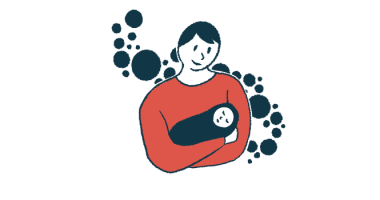Dwayne’s story: Adapting my life to smash Pompe
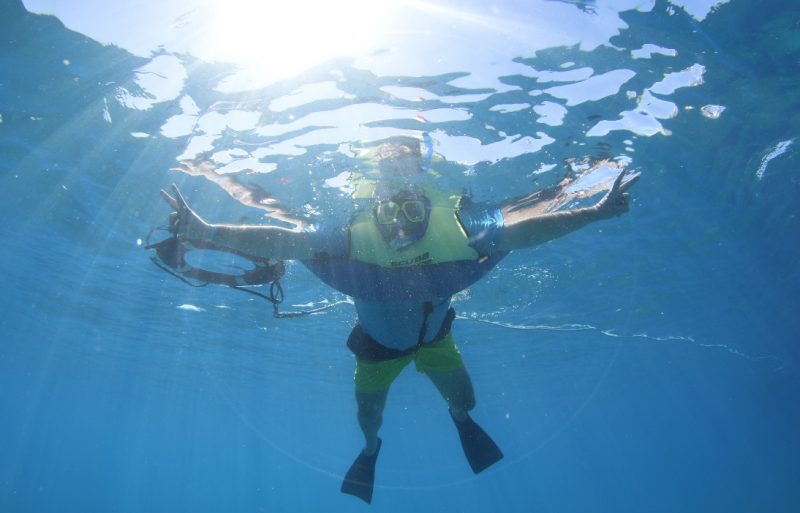
Courtesy of Ocean Joy Cruises
Dwayne Wilson, who has late-onset Pompe disease, snorkels in the water.
In the beginning of October, I spent a week in Oahu, Hawaii — my bucket list trip. I’d never been on a flight longer than three hours, and hadn’t ever taken my electric wheelchair on a plane. I was full of fear.
Once there, though, serenity washed over me. I went snorkeling on a catamaran cruise, stood on famous North Shore beaches watching the waves crash, ate seafood every day, and beheld the most magical sights.
While floating in my hotel’s lagoon as the sun set, I realized I am living my best Pompe life, to the fullest. Only four years ago, none of this would have been thought possible.

Dwayne and his wife, Jean, on their way down to the lagoon. (Photo by Dwayne Wilson)
Endings and beginnings
2018 was my worst year. In April, my 22-year-old son passed away from a brain tumor. Shortly after, I developed symptoms too severe to be chalked up simply to having just turned 50. Suddenly, my legs wobbled like Jello as I climbed the stairs to my second-floor apartment. It was a struggle to use both legs, so I clung to the handrail while ascending the two-story mountain.
Once summited, fatigue crushed me. I couldn’t stand up from seats or the toilet without pushing off with my arms. When kneeling on the floor, I couldn’t get up and had to crawl to the couch for leverage.
Terrified, I realized something was really wrong with me, not a simple pinched nerve or a slipped disk. I even considered the possibility that I had ALS.
At night when lying down, I felt short of breath — shallow breathing for five minutes until I calmed myself. Every night, I’d disturb my wife every couple hours because I made such commotion just to use the bathroom. The multiple nights without sleep compounded the fatigue.
My primary care physician referred me to a neurologist, who then performed an electromyography to record the electrical activity of my skeletal muscles and a nerve conduction study, which measured how fast electrical impulses moved through my nerves.
Those tests revealed that I had a myopathy, which is a disorder that causes muscle weakness. I mentioned to him that when in a swimming pool, it feels like someone is stepping on my chest.
He said that sounds like Pompe disease. He ordered a muscle biopsy and a Pompe blood test. Then he referred me to see a neuromuscular specialist.
On Nov. 19, 2018, the neuromuscular specialist diagnosed me with late-onset Pompe disease. Some year, huh?
Beating back at Pompe
After my Pompe diagnosis, my community moved fast to improve my quality of life. My wife and I moved out of our second-story apartment to a ground-floor apartment so I didn’t have to worry about climbing the stairs anymore.
My job as a senior technical service specialist for Toshiba America Business Solutions worked out too: I was able to still work at my desk full time, and because of the pandemic, employees can now work remotely 50% of the time. So, I work remotely from my laptop while receiving treatments.
After diagnosis, my doctor prescribed me a BiPap machine, which pushes air into and out of the lungs, to help me to get a full night’s rest. I also started physical therapy, which fortified my weak muscles and soothed my aches.
Within two weeks, I was accepted into a Pompe clinical trial, and two weeks later, I started an enzyme replacement therapy infusion (ERT). I get the ERT infusions every other week.
Because there is no cure for Pompe disease, I’ll need infusions for the rest of my life. The infusion tends to give me more energy as the glycogen stored up in the muscle cells is able to be processed and broken down to glucose, so I like to be more active after infusions.
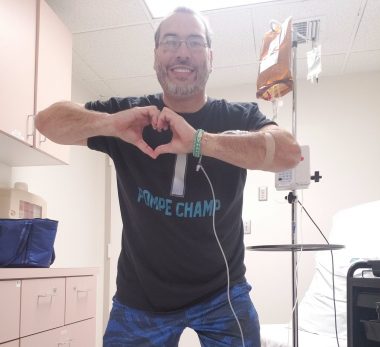
Dwayne receiving his enzyme replacement therapy. (Photo by Dwayne Wilson)
Adapting both physically and mentally
Pompe is a progressive disease, but humans are adaptive creatures. Since beginning treatment, I have adapted to Pompe.
For example, at the start of my journey, getting off the floor was nearly impossible without something to help pull and push myself up. But now I can lie on the floor and move into doing a yoga cat pose, then stand unaided from there. When on the beach, I use a ski pole to keep me balanced when walking on the sand.
When the gyms closed during the pandemic, I was determined to continue exercising so I bought an inflatable paddle board. My goal was to be able to stand on it in the water. To start, I inflated it at home and practiced standing on it to improve my balance, I stood up once in the water and fell off.
Still, I like to sit on it and use it like a kayak to explore the back bay of my home area at Newport Beach. Sometimes we need to adjust our goals to enjoy life best.
Using adaptations in more social areas can be more difficult thanks to Pompe being an invisible disease. People see this big, tall guy who walks funny and wonder why he is making a fuss about refusing to sit in a booth, or why he insists on needing to use the elevator. The truth is, I don’t have the strength in my legs to get up from a booth or climb stairs.
I recently took my sons to Disneyland a year ago, and I chose to use my electric wheelchair. I knew that all that walking would wear me out, not just for that day but for several days after. But I couldn’t help but wonder if people looked at me and wondered, “How lazy is that guy? He should get up and walk. He looks fine.”
It took me a few years, but I’ve realized I’m not less of a man for using an electric wheelchair. That technology allows me to enjoy life to the fullest. My wife is happy that I can participate in activities with her, and our friends don’t have to worry about my energy levels.
I’ve learned that using a mobility device allows me to spend more quality time with my friends and family. It lets me use my energy when I want so I can keep my body’s battery fresh for new adventures and experiences.
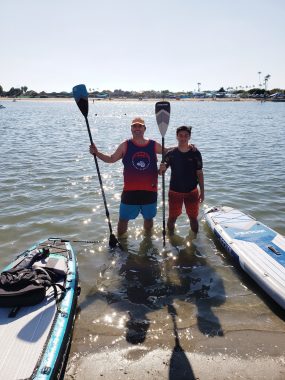
Dwayne and his son, Devin, are ready to paddleboard. (Photo courtesy of Dwayne Wilson)
Seeing my diagnosis with grateful eyes
I work hard to help others with Pompe enjoy their lives. I’ve joined several Facebook Pompe support groups, have participated in clinical trials to help with treatment research, and speak and write to raise awareness of the disease.
My community, Team Hope for Pompe, was the top fundraising team for the 2019 Los Angeles MDA Muscle Walk. I recently became a patient speaker for a biotechnology company that develops treatments for metabolic diseases.
I had an opportunity to be interviewed by my neuromuscular specialist for a presentation he did about patients living with late-onset Pompe disease at a lysosomal disease conference, the WORLDSymposium, last February in San Diego, which has been a highlight on my journey.
That led to me stepping outside of my comfort zone and becoming a writer for Pompe Disease News, published by Bionews, through a column called “On the Road to Pompe.”
I hope to inspire others to realize that getting a diagnosis of Pompe is not the end but a new beginning. Despite the hurts collected along the way, it was exactly the new beginning I needed to thrive, to see the beauty in both the little things like my frequent walks on the beach and the big things like my trip to Hawaii. Enduring my diagnosis journey has altered my entire perspective on life, especially its priorities.
I’ve determined that life is all about the adventures and experiences, soaking in the moments with loved ones, making new friends, and enriching both your life and others’ along the way. Pompe may have taken much, but it gave me a strong love for life.
Note: Pompe Disease News is strictly a news and information website about the disease. It does not provide medical advice, diagnosis, or treatment. This content is not intended to be a substitute for professional medical advice, diagnosis, or treatment. Always seek the advice of your physician or other qualified health provider with any questions you may have regarding a medical condition. Never disregard professional medical advice or delay in seeking it because of something you have read on this website. The opinions expressed in this column are not those of Pompe Disease News or its parent company, Bionews, and are intended to spark discussion about issues pertaining to Pompe disease.
About the Author
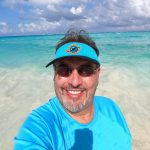
Dwayne M. Wilson lives in Southern California, in Irvine. Dwayne is a SoCal native but moved away in 1996 to experience life in the Pacific Northwest. He moved back to Orange County in 2017 to be closer to family. Dwayne was diagnosed with late-onset Pompe disease in November 2018 when he was 50 years old. Dwayne has a passion for spreading awareness about Pompe disease and bringing hope and positivity to the community. You can find him at beaches or sporting events.
Related Articles



